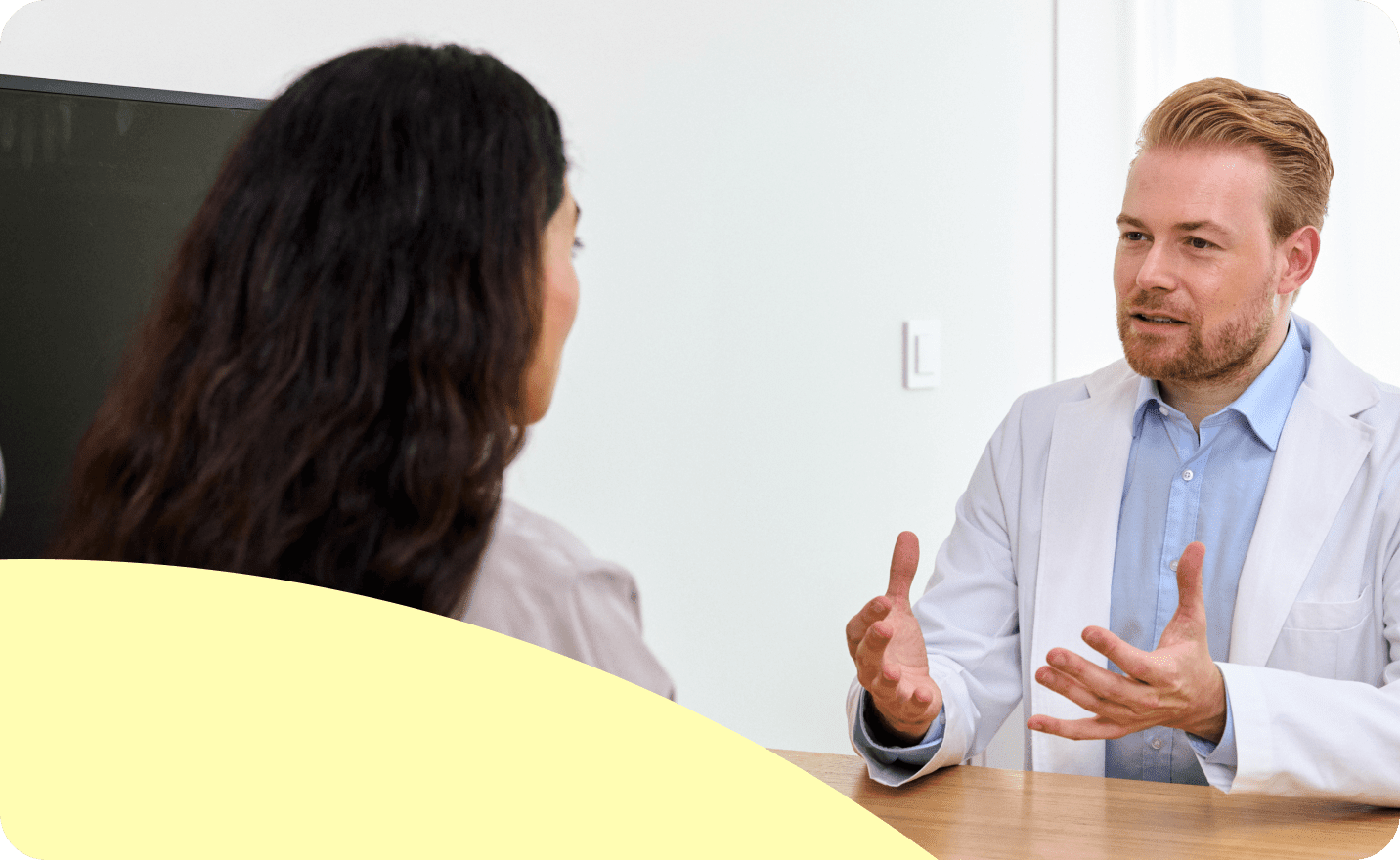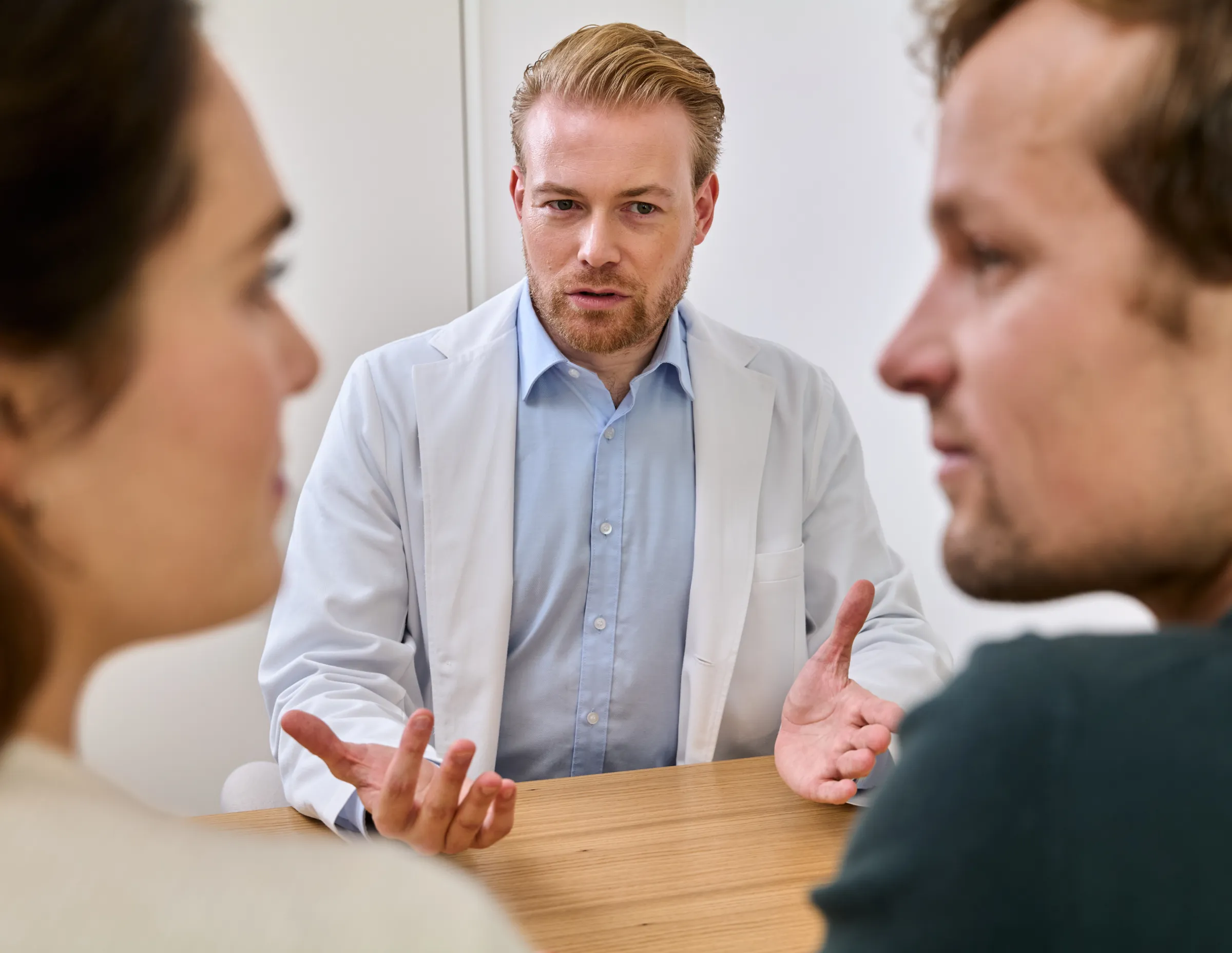Is there a difference between early menopause, primary ovarian insufficiency (POI) and premature ovarian failure? Learn about how POI affects fertility and possible treatment options.
Are you experiencing missed or irregular periods, menopausal-like symptoms and infertility? Have you been told it could be early menopause or primary ovarian insufficiency or premature ovarian failure? So many terms, but what do they all mean?
In this article, we shed some light on these terms and explain the symptoms, causes and treatment options for the condition.
Understanding the basics – what do all these terms mean?
Over the years, many terms have been used to explain a phenomenon in which women of reproductive age experience absent or irregular periods for more than four months and menopausal-like symptoms before the age of 40. These terms have led to confusion and uncertainty for the women receiving this diagnosis. Let’s start with some definitions:
- Menopause is defined by the North American Society for Menopause as the final menstrual period, which can be confirmed after 12 consecutive months without a period. This time marks the permanent end of menstruation and fertility. It is a normal, natural event associated with reduced functioning of the ovaries, resulting in lower levels of ovarian hormones (primarily estrogen). This usually starts to occur in women older than 45 years of age, with the average age of menopause being 51. The key here is that it’s the ‘permanent end’ of periods and fertility.
- Early menopause is when menopause occurs between the ages of 40 and 45.
- Primary ovarian insufficiency (POI), premature ovarian failure (POF) and premature menopause have all been used to describe the same condition. POI is the preferred term, as the term ‘failure’ gives a negative and incorrect impression of the ovarian status, as ovulation can still occur, and premature menopause does not unfold the same way as POI.
Women with POI experience partial or complete loss of periods for an extended time, usually longer than 4 months. This occurs because there is often a premature decrease in initial egg (follicle) number, an increase in egg destruction, or poor follicular response to gonadotropins. It involves a dysregulation of sex hormones; estrogen, in particular, is deficient, while levels of follicle-stimulating hormone (FSH) remain high. All this can lead to a woman being infertile (due to a lack of ovulation) and estrogen-deficient before age-appropriate menopause.
POI usually affects women before the age of 40 and can occur earlier. In some cases, adolescent girls don’t experience a period at all. Interestingly, ovarian activity can resume in women with POI and spontaneous ovulation occurs in 5-10% of these women, meaning there is the possibility of getting pregnant naturally.
This article will explain POI in terms of its symptoms, known causes, and the treatment options that are available. From this point onwards, and according to the current recommendations for the naming of the condition, we will refer to the condition exclusively as POI.
Symptoms and complications
Symptoms vary significantly in women but often include:
Changes or abnormalities in menstrual cycle:
- prolonged or missed periods
- abnormal periods
- amenorrhea – primary and secondary
Symptoms common with hypoestrogenism:
- hot flashes
- night sweats
- vaginal dryness
- dry skin
- disturbed sleep
Psychological issues:
- depression
- anxiety
- irritability
- distress from diagnosis
- neurocognitive decline
Signs of infertility:
- inability to become pregnant after 1 year despite regular, unprotected sexual intercourse at optimal times.
Causes of POI
Some healthcare professionals specialised in women’s reproductive health believe POI could be more common than originally thought. Evidence in the 1980s indicated that incidence of POI was 1 in 10,000 women in their 20s, 1 in 1,000 under the age of 30, and 1 in 100 in women between the ages of 30 and 40. Many suggest that it affects 1–3.5% of the female population. But due to lack of awareness and diagnosis, the prevalence could be much higher, and up-to-date information is lacking. The condition is often underdiagnosed or underreported for women with poor access to healthcare.
POI is categorised as being either spontaneous in nature—usually the result of genetic or autoimmune disorders—or due to exposure to toxins or medications that deplete the natural ovarian pool of eggs early in a woman’s reproductive life cycle, known as iatrogenic POI. Recent advances and research surrounding the condition are now offering some possible causes:
- Toxins and injury—chemotherapy or radiotherapy given to a woman at some stage of her life may provoke a depletion in her egg supply due to the toxic effects of the therapy. Young women who have to undergo chemo- or radiotherapy should be offered ovarian tissue cryopreservation or oocyte cryopreservation.
- Surgery—some forms of pelvic surgery such as laparoscopy or oophorectomy could impact the blood supply to the ovary and cause damage or inflammation, potentially causing POI.
- Family history of early menopause or POI can account for 10–15% of spontaneous POI in first degree relatives. However, POI and family history is often due to genetic disorders.
- X chromosome disorders can result in POI due to poor reproductive organ development. Certain chromosomes are either deleted, inversed or duplicated, such as in Fragile X syndrome (FMR1), Turner syndrome, or Triple X syndrome. For example, women with Turner’s syndrome have an adequate number of eggs when they are born, but reserve quickly declines and menopause can occur even before puberty.
- Genetic syndromes, which cover whole gene or single gene variants can affect the development of eggs during embryogenesis and result in POI.
- Autoimmune conditions – the exact prevalence of autoimmune conditions in women with POI is unknown. A recent study found that among 52 women with confirmed POF, 40.4% had at least one confirmed autoimmune disease such as Hashimoto’s disease, systemic lupus erythematosus, or rheumatoid arthritis, to name a few. The study also found that these women also had a poorer infertility treatment outcome. POI also has higher prevalence among women with Addison’s disease.
- Infections: bacterial (tuberculosis, shigella), viral (mumps, cytomegalovirus, varicella), or parasitic (malaria)
Diagnosis
Unfortunately, POI is not a condition that is often recognised, and diagnosis is therefore delayed. A lack of awareness from healthcare professionals over the years and little research into why young women may experience loss of periods and infertility could be a reason for this.
Delayed diagnosis can significantly affect the general health and mental well-being of women, as symptoms can become severe, and long-term estrogen deficiency can cause various health implications, such as osteoporosis, cognitive decline, and neurological disturbances. Seeking an early diagnosis is key in getting the correct treatment and determining the best options for getting pregnant. Also, for women who are close to 40 years of age, the doctor needs to rule out menopause and determine if there is an underlying condition involved.
In general, POI is diagnosed by three characteristics:
1. Elevated FSH levels (> 25 IU/L) on two occasions > 4 weeks apart
2. Four or more months of oligo/amenorrhea
3. Age < 40 years
However, these defined characteristics are somewhat rigid, and women may experience varying serum hormone changes and spontaneous periods. To understand the condition and why it may be affecting a woman, an early and thorough investigation needs to be done; this is usually performed through blood/lab analysis or imaging.
Pregnancy test
As women with POI have irregular periods, the doctor will first rule out if the woman is pregnant.
Laboratory test
A doctor will request several blood tests, usually > 4 weeks apart and sometimes at specific stages of your cycle. The tests look for the following:
- Serum hormones: FSH, luteinising hormone, estradiol (a form of estrogen), anti-Müllerian hormone and thyroid stimulating hormone levels will all be tested. Persistently high levels of FSH and low levels of estradiol will give a strong indication that the ovary is not functioning correctly.
- Genetic testing: is not usually offered immediately unless there is a family history of the condition, or a suspected genetic cause. Various genes as well as chromosomal disorders have been linked to the condition. A karyotype analysis (to analyse the profile of a person’s chromosomes) and a genetic test screen for specific genes that regulate follicle development and maturation e.g. NOBOX or BMP15 genes, will help determine if the condition is the result of genes or chromosomes.
POI is most likely polygenic in nature, meaning several genes rather than one are responsible for the condition. If the screening reveals a specific gene responsible for the condition, it will help the doctor understand what process of the menstrual cycle and reproductive system is being affected by that gene and, if possible, offer a treatment option that could compensate for the malfunction. However, gene-specific treatments for POI are not available yet and more research is needed. Genetic testing is best carried out with a multidisciplinary team, which could include geneticists, counsellors, gynecologists, and endocrinologists. - Autoimmunity screening: thyroid autoantibodies and 21-hydroxylase antibodies will give an indication of whether the thyroid and/or the adrenal glands are functioning correctly. The thyroid and adrenal glands are responsible for hormonal regulation, if they are not functioning correctly, it may result is a dysregulation of sex hormones that control the menstrual cycle. If women test positive for any of these autoimmunity screening targets, then yearly tests to monitor levels are advised, as well as seeking specialised advice from an reproductive endocrinologist.
- Infection: certain bacterial and viral infections have been associated with POI; therefore, a blood test to reveal an infection would be a good indication if the POI is driven by the infection. If the infection is treated, then there’s a chance that normal ovarian function can be restored.
Imaging
A pelvic ultrasound (ideally vaginal) will allow a gynaecologist to visualise the ovaries and determine if there are signs of small ovarian volumes, and low number of ovarian follicles (immature eggs), this is known as an ovarian reserve test. Some doctors may request a specialised X-ray to calculate the bone mineral density (BMD), which could be affected by estrogen-deficiency.
Treatment
As there is no cure for POI, treatment options will focus on:
- controlling symptoms
- protecting against the effects of estrogen-deficiency
- therapy and techniques to improve psychological well-being and mental health
- improving an existing condition that could be the cause of POI
- achieving pregnancy, where desired
Hormone replacement therapy
Despite concerns of the use of hormone replacement therapy (HRT) in recent years due to poorly designed studies, estrogen therapy is safe and effective for women with POI for many reasons:
- Menopausal symptoms: therapy to maintain normal estrogen levels can help alleviate menopausal-like symptoms, such as hot flashes, night sweats, sleep disturbances, mood instability. Local application of estrogen can address vaginal dryness, painful sex (dyspareunia) or genito-urinary problems.
- Cardiovascular health: HRT can help reduce the risk of cardiovascular health issues and stroke. Although, data is lacking and mainly focused on age-appropriate menopausal women, research shows that estrogen therapy in women with POI can improve cholesterol metabolism and reduce the risk of atherosclerosis (narrowing of arteries due to plaques) within 6 months of treatment.
- Protect bone health (osteoporosis): Low estrogen levels can lead to increase risk of fracture, and women with POI have been shown to have lower bone mineral density (BMD). HRT can help alleviate this risk. Doctors will usually assess BMD after the initial diagnosis assessment of POI.
- Neurocognitive improvements: low estrogen levels have been associated with a decline in neurocognitive ability. Restoring estrogen levels have been suggested to improve this cognitive decline in women with surgical menopause or surgical POI. However, data is lacking for spontaneous POI and more research is needed.
- Recommended dose: estrogen therapy should mimic the natural levels of the hormone in the body of about 100 pg/ml and once started, can be taken until the average age of natural menopause (51 years). But the dose may be higher in early POI (post-puberty). Estrogen can be given in oral form, a cream applied to the skin or vaginally using a ring or intrauterine device (IUD). The dose for these varies and doctors would advise to keep a symptoms chart to track which dose is optimal to improve quality of life.
Hormonal birth control
If a woman with POI is not trying to get pregnant, a doctor may prescribe hormonal birth control to correct the hormonal balance. This can be in the form of a combined pill (containing both estrogen and progesterone) or a progesterone-only form. The doctor will explain all the options available to find the best hormone control pill for the symptoms experienced by the women.
Psychological interventions
Women who receive a POI diagnosis may feel shock and confusion, especially if the diagnosis is unexpected. Compromised fertility, increased risk of premature aging, and just feeling different can lead to anxiety, depression, fear, and low self-esteem in women with POI. Therefore, psychological support in the form of therapy can be extremely beneficial.
Also, having a good support network with partner, friends and family can make a woman realise she’s not on her own in her journey. Seeking professional support and finding ways for healthy mental wellbeing such as sport, meditation, yoga can be extremely beneficial.
Pregnancy
Women with POI can still ovulate, and a systematic review in 1999 found that women with POI had a 5–10% chance of conceiving after diagnosis, but due to the nature of the condition, ovulation is often unpredictable and sporadic. Therefore, timing conception becomes more difficult.
There are no effective treatment strategies to restore ovarian reserve, but as sporadic ovulation can happen, so can pregnancy, and once conception has occurred, there are no indications of additional risks for the baby in women with POI.
If a woman with POI experiences infertility (no pregnancy within 12 months of unprotected sex), then she can follow methods of assisted reproductive technology such as gonadotropin therapy, IVF and IUI. Finally, she may try donor egg conception through IVF; this option is not available in Switzerland, where egg donation is currently prohibited.
For women with genetic or chromosomal POI who are attempting to conceive, it is advised to seek advice from a genetic specialist who can determine the risk of a woman passing on the genetic or chromosomal mutations to her offspring and do a general medical and endocrine examination before pregnancy. For these women, perhaps donor eggs may be a reliable option to reduce fetal risk factors. Women with POI who plan to go through egg donation should have a thorough examination of thyroid and adrenal functions before conception. But specialised counselling should be sought.
Lifestyle interventions
As mentioned in many of our articles, good lifestyle habits can go a long way for a woman’s health. Optimising diet and exercise and avoiding smoking and excessive alcohol use can help restore hormonal and menstrual imbalances.
A high calcium and vitamin D intake is recommended in these women. Both help maintain bone health. Adults generally require 700 mg of calcium per day and 10 ug of vitamin D. Getting enough vitamin D from food alone can be difficult, so supplements are recommended.
New therapies
Two new advances in the field of restoring ovarian function are in vitro activation (IVA) followed by auto-transplantation of ovarian tissue and oogonial stem cell therapy. These are still in the research phases but are discussed in this review.
Takeaway
POI is a complex condition. Seeking advice from a reproductive specialist will help to clarify whether a woman might have POI, and in the case that she does, which treatment options are available to help her deal with the condition. The treatment pursued will usually depend on a woman’s desires and goals, such as whether she would like to become pregnant.
At Cada, our caring team puts individuals at the centre of their fertility care. Would you like to discuss this issue or others concerning reproductive health and fertility? Get in touch with us so that we can figure out how best to help you. Reserve your spot for a personalised consultation today.







